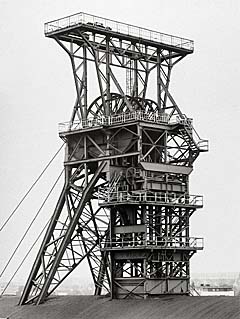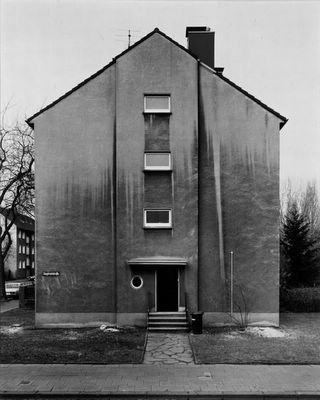
Bernd & Hilla Becher, Förderturmkopf, Grube Anna, Alsdorf bei Aachen D, 1979

Bernd & Hilla Becher, Zeche Ewald Fortsetzung, Recklinghausen, Ruhrgebiet, Deutschland, 1982
«Bernd and Hilla Becher
Essay by Lynne Cooke
Vernacular industrialized architecture has been the sole subject of Bernd and Hilla Becher's work for some forty years. Their vast photographic inventory now ranges geographically from western Europe through North America and taxonomically across an enormous array of heterogeneous building types, many verging on obsolescence—mine shafts, lime kilns, silos, cooling towers, blast furnaces, tipples, gasometers—all classified by reference to function. The initial impetus that led the young Bernd Becher to begin photographing such subjects in the late 1950s was purely practical: he wanted to use his recordings as raw material for the paintings he was then making in a Neue Sachlichkeit style. In those same years Hilla Becher, née Wobeser, apprenticed and briefly worked in a professional advertising studio, where she developed a passion for photographing technical and mechanistic subjects. Once husband and wife started working together, in 1957, they assumed identical roles: tasks are not separately assigned to one or the other; both are involved in scouting sites, negotiating with the owners and other authorities, setting up the cameras, and printing. The art they have produced does not fall within conventional categories of documentary photography, though it has many affiliations with that long-standing tradition. The disciplined ethic with which this dedicated German couple defined, then refined, their project of recording for posterity the increasingly neglected relics of the industrial era, with its domestic offshoots, has yielded not just an aesthetic but a vision.
From their earliest publication, titled tellingly Anonyme Skulpturen: Eine Typologie technischer Bauten (Anonymous Sculpture: A Typology of Technical Buildings), 1970, the Bechers' work has circulated within the realm of contemporary art practice and discourse. Certain features of their art, the hallmark of which is, in Charles Wright's felicitous phrase, "a controlled beauty," make this positioning particularly apt—though the Bechers themselves do not regard the issue as of great import.1 Typically, their works present each industrial motif in what soon evolved into a rigorous, disciplined signature manner whose focus is an exploration of the relation between the subject's function and the resulting photographic representation. Isolated, centered, and frontally framed, each motif is shot in as objective a manner as possible. The combination of large-format cameras and finely grained black-and-white film ensures a remarkable tonal range in each print. By working only under slightly overcast skies and early in the morning during the seasons of spring and fall, the Bechers are ensured of an even, diffuse light with minimal shadows, a lambent ambience that enhances their intensive focus on the motif, which is revealed in crystalline detail, grounded in a formal factual clarity. All anecdotal incident, such as intrusive foliage, stray animals, and humans, is sedulously avoided: nothing disturbs the systematic ascetic neutrality. Tellingly, the vantage point tends to be subtly elevated. "Looking at an object from a point half way up it [causes] it to appear before you in its full reach and free of distortion," they explain.2 The raised camera position also causes the horizon to appear to recede, the surroundings to become more panoramic, and the object to stand forth prominently so that, while clearly related to its environment, it simultaneously appears somewhat removed, apart, an effect enhanced by the expansive neutral skies. The results evidence a brilliant understanding of scale relations—of how a vast structure can be made to fit a small-sized pictorial format—without rhetoric or expressive distortion.
By the mid-1960s the Bechers had also settled on a preferred presentational mode: the grid. Groupings of prints, each print measuring sixteen by twelve inches or smaller, either framed discretely or encased within a single large frame, facilitate direct, immediate comparison between motifs, which are arrayed without hierarchy, according to type, function, and/or material. Juxtaposition permits industrial structures that at first might appear prevailingly similar, even uniform, to register as significantly different one from another. Given that most viewers know little about the economic, engineering, and functional requirements that determine the generic forms and characters of these structures, comparison of the several components in any of these multipartite works operates primarily at a formal level—that is, in an aesthetic dimension. Differences and similarities among related motifs consequently appear as variations on an ideal form, given that the structures are family members from the same species. Specific subjects are interpreted as anonymous plastic forms—as anonymous sculpture.
In 1989–91, for an exhibition at Dia in New York, the Bechers introduced a second format into their oeuvre: single images that are larger in size—twenty-four by twenty inches—and presented individually rather than as gridded tableaux. Several galleries within this extensive exhibition were devoted to a specific subject, a strategy that allowed new typologies to cohere. This presentational strategy was heralded in part by a series of finely printed publications that they had begun to produce, beginning with Framework Houses, in 1977. This was soon followed by, among others, Water Towers (1988), Blast Furnaces (1990), and Pennsylvania Coal Mine Tipples (1991), the latter timed to mark the Dia show. Devoted to one kind of industrialized plant, this ongoing series of books constitutes a type-by-type corpus documenting a rapidly dying industrial age. The brief texts that the artists wrote to accompany the first books in the series provided information on the genesis of the various typologies, offering a historical positioning that corresponded to the inclusion, in the captions, of the date on which each building was constructed together with the year in which the photograph was taken. In more recent publications this approach has been superseded by accounts that concentrate on how the plants function, an approach paralleled by the elimination of the plants' dates from the captions. Taken together, these decisions further abstract the subjects from their sociohistorical ambience in favor of a concentration on the typological relation of the individual instance to the generic, of the single member to the species or class.
For Dia:Beacon the Bechers ring further changes on their presentational modalities by capitalizing on the fact that the gallery they selected for their work is divided into two equal parts. All the photographs in one half of the space are partial views, which are relatively unusual in their oeuvre. Some of these are sequenced by type into small subsets. For example, three of the Winding Towers are installed on one wall; the Blast Furnaces hang on another. A diptych—a format they rarely employ—occupies one of the two short walls that bisect the gallery. Most of these images, which have seldom been exhibited, were recorded in the late 1980s and early 1990s, reflecting a subtle shift of focus in their work. The one "vintage" image, from 1968, is formally no different, testimony both to the roots of this reorientation in certain early forays and to the remarkable consistency and cohesion of their methodology and aesthetic.
The other half of the gallery is devoted to Aggregates, that is, to details of large-scale machinery, pipes, conduits, and metallic containers that belong to a diverse range of plants. A suite of eight lime kilns, vessels of one of the oldest and most commonplace processes long proceeding the onset of the industrial age, and hence frequently found in their archive, are counterpointed by images of plants that involve what are, for them, unusually contemporary procedures and proces-ses—notably, Styrofoam and petrochemical production.
Tracing the history of a rapidly declining industrial era many of whose older technical processes and functions are now defunct, and of individual buildings decaying or threatened with destruction, is an important impulse in the Bechers' practice. Well aware of the fine-art and commercial portrayal of industry by previous specialists and by trade photographers alike, they have gradually assembled a second archive to probe and survey the recording of this thematic from other perspectives. Primarily heuristic in function, the counterarchive both expands and focuses their knowledge of their subject matter. In contrast to those predecessors whose work constitutes a traditional industrial archaeology, a particular level of self-conscious awareness and reflexivity defines and distinguishes their enterprise.
While foregrounding the urgency of their archival mission, the Bechers also stress their concern for canonical documentary procedures, such as ensuring the legibility of the image: "The photographs should always show all the details and the textures of the materials," they insist,3 adding that they let "the forms speak for themselves and become readable," that they refuse "to hide or exaggerate or depict anything in an untrue fashion."4 Viewed in this light, their work may be placed in a lineage stemming from such early modernist luminaries as Eugène Atget and August Sander, rather than in relation to artisanal modes of the kind that subtend industrial archaeology. Sander sought to classify into a pictorial catalogue, in a "style devoid of style," the professional and social types that made up modern Germany. The resonant formal uniformity of his lifelong project Menschen des 20. Jahrhunderts (Man in the Twentieth Century) exceeds the strictly documentary, becoming a cornerstone in the history of twentieth-century modernism. The Bechers are today the foremost exponents of that revered legacy.
They are nonetheless fully attuned to the contemporaneous practices of many fellow artists who, in the 1960s, began to use the camera as a convenient tool for recording and documenting. Notable among these artists were Robert Smithson, whom they assisted when he arrived in the Ruhr district in 1968 to explore the demise of the industrial era from a very different perspective, and Hanne Darboven, whose project engaging collective cultural memory, Kulturgeschichte 1880–1983 (Cultural History 1880–1983), 1980–83, shares certain impulses, methodologies, and techniques with the Bechers. Other parallels may be drawn with such artists as Sol LeWitt, Donald Judd, Carl Andre, and Ed Ruscha (with his deadpan early book projects), who based their compositional and structural modalities on seriality and permutation. In addition, Judd and many of his peers shared the Bechers' appreciation for and knowledge of anonymous industrial structures, vernacular building types, and early modern as well as contemporary engineering.5 These affinities and confluences generated the discursive context for the initial reception of their work, one that subsumed archaeological, sociological, and strictly photography-based critiques into a late modernist agenda centered in formal, structural, and serial procedures. Highly influential as teachers, the Bechers have in turn shaped another generation of artists both orthodox and aberrant, notable among them Thomas Struth, Candida Höfer, and Thomas Ruff, their former students from the Kunstakademie Düsseldorf.
Notes
1. Charles Wright, "Foreword," in Bernd and Hilla Becher, Pennsylvania Coal Mine Tipples (New York: Dia Center for the Arts, 1991), n.p. "The question if this is a work of [fine] art or not is not very interesting for us," Hilla Becher has stated on a number of occasions. See, for example, Carl Andre, "A Note on Bernhard and Hilla Becher," Artforum 11, no. 5 (December 1972), p. 59.
2. Bernd and Hilla Becher, quoted in "Interview mit Bernd und Hilla Becher," in Bernd und Hilla Becher (Munich: WB Verlag, 1989), p. 14.
3. Bernd and Hilla Becher, quoted in Angela Grauerholz and Anne Ramsden, "Photographing Industrial Architecture: An Interview with Bernd and Hilla Becher," Parachute 22 (Spring 1981), p. 15.
4. Ibid., p. 18.
5. Donald Judd's review of the 1964 exhibition "Twentieth Century Engineering" at the Museum of Modern Art, New York, is telling here. See Judd, "Month in Review," Arts Magazine 39, no. 1 (October 1964), reprinted in Donald Judd: Complete Writings 1959–1975 (Halifax: The Press of Nova Scotia College of Art and Design, and New York: New York University Press, 1975), pp. 136–39.
© 1995-2005 Dia Art Foundation»

Bernd & Hilla Becher, Winding Towers, 1967-1988, 2003
Mais informação:
- Dia Art Foundation
- Excerto do vídeo "Contacts" Bernd & Hilla Becher realizado por Jean-Pierre Krief em 2002 no Arte

Bernd & Hilla Becher, Haus V, Duisberg, Ruhrgebiet, 1989
























Sem comentários:
Enviar um comentário